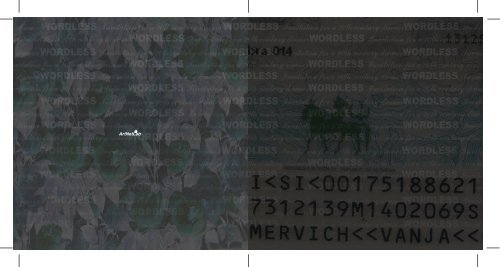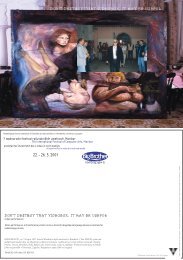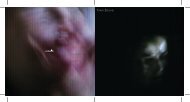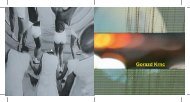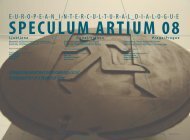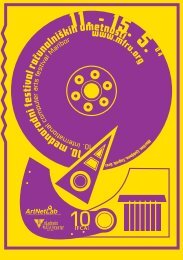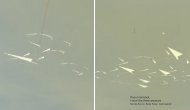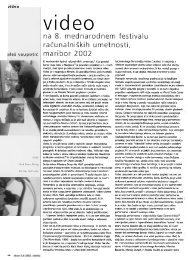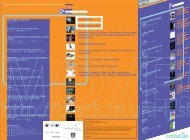Untitled - ArtNetLab
Untitled - ArtNetLab
Untitled - ArtNetLab
You also want an ePaper? Increase the reach of your titles
YUMPU automatically turns print PDFs into web optimized ePapers that Google loves.
KODE IN IDENTITETE<br />
Identiteta posameznika ni le ena, mnogo jih je in neprestano jih menjavamo. Hkrati smo lahko otroci, starši, ljubimci,<br />
bralci, uslužbenci, študentje, meščani ali državljani… Obstajajo identitete, ki si jih nadenemo v intimi in tiste, ki jih<br />
prevzemamo v javnosti. Identiteta nas določa, a nikoli ne zmore razkriti, kdo zares smo. Človek je vedno veliko več kot<br />
zgolj Stanetov sin, Marijin oče, tisti, ki bere Gogolja, prodajalka, Kamničan ali Slovenka. Identiteta je le znak, ki opiše del<br />
našega življenja, pa vendar nas lahko usodno zaznamuje. Novomedijska projekta Brez besed (2005) in Povabilo na<br />
večerjo 20. stoletja (2006) Vanje Merviča raziskujeta raznolikost in omejenost družbenih identitet ter njihovih kodov.<br />
Državni ustroj naše identitete standardizira, jih šifrira in kodira s posebnim jezikom. Naša življenja - skupek preživetih<br />
trenutkov, neizrečenih misli, nežnih dotikov in prelitih solza, so spremenjena v kode, s pomočjo katerih nas država<br />
imenuje, razvršča, prepoznava, razume, nadzira in upravlja z našimi življenji.<br />
Eden izmed sistemov znakov - posebna birokratska koda, ki določa eno izmed naših identitet, je Enotna matična številka<br />
občana (EMŠO). EMŠO, številka, ki je bila v uporabi zgolj na območju bivše SFRJ, je bila občanu dodeljena v trenutku<br />
njegovega rojstva in ga je spremljala vse do smrti. Sestavljena iz šestih delov - dneva, meseca in leta rojstva, številčnega<br />
znaka regije, vrstne številke rojstva v regiji in kontrolne številke, izračunane s pomočjo posebej za EMŠO razvitega<br />
javnega algoritma - predstavlja poseben kodni sistem, jezik, ki nam sporoča določene podatke o občanu.<br />
EMŠO državi in njenim uslužbencem govori o našem spolu, starosti in kraju našega rojstva. Ta skupek števil država<br />
uporablja pri zdravstvenem varstvu in zavarovanju, davkih in carinah, obrambi, urejanju prostora, zaposlovanju in<br />
spremljanju delovne sile, pokojninskem in invalidskem zavarovanju, pravosodju, šolstvu, socialnem varstvu in drugih<br />
statistikah. EMŠO človeka spremeni v številko, ki zabriše njegovo človeškost.<br />
Mervičev projekt kodo izrabi za nastanek poetike podob. Vnos EMŠO v posebno okence ustvari enkratno kombinacijo<br />
video podob na ekranu. Sistematizirana, standardizirana številka sproži nastanek umetniškega dela. To je sintetizirano za<br />
vsakega posameznika, ki vnese pravilno EMŠO kodo. Posamezniku lastna številka, ki, kakor mnogo drugih osebnih<br />
kontrolnih kod s sebi lastnim, matematično ustvarjenim znakovnim jezikom, dodobra kontrolira naša življenja, sproži<br />
edinstveni tok podob, ki ga poleg uporabnika - imetnika EMŠA, spremlja celotno galerijsko občinstvo. Šifra za javno<br />
uporabo, ki naj jo posameznik po naročilu državne oblasti skrbno hrani, saj je dostopna enoznačnemu branju vsakogar, ki<br />
pozna skrivnosti EMŠO jezika, sproži intimen flux podob, ki je prikazan javnosti, a ponuja mnogovrstna branja. Birokratski<br />
jezik, ki našo identiteto omeji na zbir podatkov, je v umetniškem delu razpršen v tisoč možnih pomenov. Umetnost, ki za<br />
svoj medij izbira sodobno tehnologijo v tem in tudi v naslednjem Mervičevem projektu presega svojo medijsko specifiko<br />
in vanjo vnaša poetično izraznost.<br />
Če projekt Brez besed identiteto z uporabo EMŠA omeji na eno samo, ki pa je edinstvena za vsakega imetnika kode,<br />
Povabilo na večerjo 20. stoletja omogoča njeno spreminjanje. Družbenost večerje, posebnega obreda preobloženega s<br />
pomeni, katerega reference prek ključnega prizora krščanske simbolike segajo globoko v mitološko preteklost, je Mervič<br />
v projektu prestavil na konec 20. stoletja. Dogodek, na katerega nas vabi umetnik in vabilu dodaja opozorilo, naj nanj<br />
nikakor ne pridemo prepozno, je že minil. V začetku enaindvajsetega stoletja nas umetnik vabi, da si izberemo eno izmed<br />
stereotipnih identitet, značilnih za površno podobo sveta, ki so nam jo s pomočjo množičnih medijev ustvarili ob koncu<br />
preteklega stoletja. Uporabniki projekta tako v realnem času prisostvujemo preteklosti, ki se za nas predvaja v<br />
sodobnosti.<br />
Fotografija našega obraza zapolni praznino izbrane uniformirane podobe. Za hip lahko postanemo glasbeni zvezdnik,<br />
terorist, heker, znanstvenik, porno diva ali paraplegik. Stereotipna zunanjost je dopolnjena z našo podobo, praznina je<br />
izpolnjena. Toda tudi tako dopolnjena podoba še vedno ostaja zgolj prazen znak. Umetnik nam kaže izpraznjeno sodobno<br />
družbo v kateri videz navidezno določa vsebino. V družbi, v kateri je treba delovati hitro in učinkovito, tipizirani jezik<br />
podob uporabljamo, da ustvarjamo lastno reprezentacijo, s katero družbi kažemo naše želje, moči, strahove, ljubezni,<br />
status in prepričanja, se povezujemo v skupine ali se od njih ločujemo. Izbira prepoznavnih obrazcev je velika, toda kaj<br />
nam zares pove o posamezniku<br />
Petja Grafenauer Krnc<br />
Društvo za povezovanje umetnosti in znanosti <strong>ArtNetLab</strong> je produkcijsko-organizacijska<br />
entiteta, ki vzpostavlja platformo za nastajanje novomedijskih umetniških projektov<br />
najmlajših generacij umetnikov, tako da nudi organizacijsko podporo sodelovanju med<br />
Akademijo za likovno umetnost in oblikovanje ter Fakulteto za računalništvo in informatiko<br />
Univerze v Ljubljani. Osrednja institucija <strong>ArtNetLab</strong>a je organiziranje Mednarodnega<br />
festivala računalniških umetnosti, ki omogoča tako realizacijo kot predstavitev del,<br />
obenem pa odpira možnost neposrednega stika novih novomedijskih del z mednarodno<br />
uveljavljenimi projekti s tega področja. Aleš Vaupotič, <strong>ArtNetLab</strong><br />
Society for Connecting Art and Science <strong>ArtNetLab</strong> establishes a platform for production<br />
management of new media art projects by the youngest generations of artists. It offers<br />
organisational support for the collaboration of the Academy of fine art and design and the<br />
Faculty of computer and information science, University of Ljubljana. The key institution of<br />
<strong>ArtNetLab</strong> is our organization of the International Festival of Computer Arts, making<br />
possible the realization and presentation of the works and at the same time opening up<br />
the possibility of direct contact of the new new media works with internationally<br />
established projects from this field. Aleš Vaupotič, <strong>ArtNetLab</strong><br />
Vanja Mervič: Brez besed/Wordless (2005), Povabilo na večerjo 20. stoletja/<br />
An Invitation for a 20th Century Dinner (2006)<br />
Besedila/Texts: Petja Grafenauer Krnc, Vanja Mervič.<br />
Uredili/Edited by: Narvika Bovcon, Aleš Vaupotič.<br />
Založil/Published by: <strong>ArtNetLab</strong> Društvo za povezovanje umetnosti in znanosti.<br />
<strong>ArtNetLab</strong> Društvo za povezovanje umetnosti in znanosti/<br />
<strong>ArtNetLab</strong>Society for Connecting Art and Science,<br />
Trubarjeva 76a, 1000 Ljubljana<br />
narvika.bovcon@guest.arnes.si<br />
http://black.fri.uni-lj.si/<br />
Zanj/Presented by: Aleš Vaupotič.<br />
Prevod/Translation: Sunčan Stone.<br />
Oblikovanje/Design: LIMB.<br />
Tisk/Print: VZA Logatec.<br />
Naklada/Number of copies: 300.<br />
Leto/Year: 2007.<br />
Zahvale/Thanks to:<br />
FRI, ALU, SNG NOVA GORICA, MULTIMEDIJSKI CENTER MOSTOVNA, VASJA<br />
KOKELJ, JOŠKO MARKIČ, SAMO OBLOKAR, HARLEM UNDERGROUND, MESTNA<br />
OBČINA NOVA GORICA, PETJA GRAFENAUER KRNC, VSEM STATISTOM PRI<br />
VEČERJI 20-EGA STOLETJA/20TH CENTURY DINNER EXTRAS (KATJA ROBIČ,<br />
JURE POŠA, BOGOMIR TRPIN, JASNA PRINČIČ, NINA URŠIČ, ALEKSANDER<br />
MAVRIČ, VASJA PELHAN, DECO, DRAGAN-MACHO MAN, ROMILDO KUMAR, VASJA<br />
DRAŠČIČ, BOŠTJAN KOMEL, MATEJ DOLJAK, LUKA MANOJLOVIČ, PETER<br />
MIGNOZZI, MATJAŽ KRAMAR), ALEKSANDER BLAŽICA, KUD LIMB, HARLEM NOISE<br />
COLLECTIVE, KRISTJAN PUGELJ, LARA JANKOVIČ, ANA FACCHINI, ALFRED DE<br />
LOCATELLI, SERGIO FIGAR, IGOR MAČKOVŠEK, GIUSSEPE ANELLO, HILDA<br />
HANSEN, MOJCA VALIČ, MARJUTA SLAMIČ.<br />
CIP - Kataložni zapis o publikaciji<br />
Narodna in univerzitetna knjižnica, Ljubljana<br />
7(497.4):929Mervič V.<br />
MERVIČ, Vanja<br />
Wordless ; An invitation for a 20th century dinner / Vanja<br />
Mervič ; [besedila Petja Grafenauer Krnc, Vanja Mervič]. -<br />
Ljubljana : <strong>ArtNetLab</strong> - Društvo za povezovanje umetnosti in<br />
znanosti, 2007<br />
ISBN 978-961-92000-0-1<br />
1. Mervič, Vanja: An invitation for a 20th century dinner<br />
231504128
Vanja Mervič<br />
Rojen 13.12.1973 v Kopru.<br />
Maturiral je na Instituto d´arte Max Fabiani, Gorizia.<br />
Prva dva letnika končal na beneški akademiji, v letu 2001 pa je diplomiral na Accademia di Brera v Milanu.<br />
1999 je bil na študentski izmenjavi na Hoogeshool, 3D-multimedia v Gentu, Belgija.<br />
Vpisan na magistrski študij smer video in novi mediji na ALU Ljubljana, mentor Srečo Dragan.<br />
Born on the 13th of December 1973 in Koper, Slovenia.<br />
He finished his A levels at Instituto d'arte Maks Fabiani in Gorizia, Italy.<br />
For two years he frequented Accademia di Belle Arti Venezia. He transferred to Accademia di Brera in Milano and graduated in 2001.<br />
In 1999 he was as an exchange student at Hoogeshool, 3-D multimedia in Gent, Belgium.<br />
From 2004 he has been attending a post graduate course in video and new media at the ALU, Ljubljana, mentor Srečo Dragan.<br />
DELAVNICE/WORKSHOPS:<br />
-Bloegroup, (Sam Bogart), Kunstcentrum Voruit, Gent, (B), 1999<br />
-"Long pose", Pascal Bass, Hoogeschool, Gent, (B), 1999<br />
-Toonel Fabrik Amsterdam, Kunstcentrum Voruit, Gent, (B), 1999<br />
-"Da cosa nascie cosa", Fondazione Pistoletto, Gorizia,(I)-Nova Gorica, (SLO), 2006<br />
-"Le chiavi di Ichnos tra cielo e terra", Perfugas, Sardinija, (I), 2006<br />
-"Web Jay-ing software", Anne Roquigny and Stephane Kyles, Kiberpipa , Ljubljana, (SLO), 2006<br />
-"Wherever we go - Ovunque andiamo", z Adrian Paci, Via Farini, Milano, (I), 2006<br />
-"Public art", Antoni Muntadas, Via Farini, Milano, (I), 2006<br />
IZBOR SKUPINSKIH RAZSTAV/SELECTED GROUP EXHIBITIONS:<br />
-"Ex Tempore", Piran, (2. nagrada/2nd prize), (SLO), 1996<br />
-"Nuove Figure", Galerija /Gallery Tragetto, Venezia, (I), 1996<br />
-"Linguaggi in diagonale", Lecce, (I), 1997<br />
-"Salon 1", Museo della Permamaente, Milano, (I), 1998<br />
-"Rainbow for dinner", Kunstcentrum Voruit, Gent, (B), 1999<br />
-"Waiting", Kunstcentrum Voruit, Gent, (B), 1999<br />
-"Octavo", ACEK, Gent, (B), 1999<br />
-"Sewing", Film Video monitor, Gorizia, (I), 2000<br />
-"Arte oggetto", Buje, (I), 2001<br />
-"Začasni delavec"/"Part time employee" Galerija/Gallery Alkatraz, Ljubljana, (SLO), 2002<br />
-"12 + 4", razstava ob vstopu Slovenije v EU z Vasjo Kokelj, Ivem Tabarjem/an exhibition with Ive Tabar and Vasja Kokelj for the occasion of<br />
Slovenia entering United Europe, javni prostor/open space, Nova Gorica, (SLO), 2004<br />
-MMMArt Medana, Kulturni dom, Gorizia (I) 2005<br />
-11. mednarodni festival računalniških umetnosti/11th International Festival of Computer Arts, Maribor, (SLO), 2005<br />
-Predstavitev projekta/Presentation of the project "Wordless", net.culture club MAMA, Zagreb, (HR), 2005<br />
-"Wordless", galerija Hodnik - galerija sodobne umetnosti/gallery of Contemporary Art Celje-Hodnik, Celje, (SLO), 2005<br />
-"Arhipelag", javni prostor/open space, Nova Gorica, (SLO), 2005<br />
-"Vissages francofones - vissage de la Slovenie", museum Henri-Martin, Chantrerie, Crenier du Chapitre, Chaors, (FR), 2005<br />
-"Wordless", <strong>ArtNetLab</strong> production 05, Galerija/Gallery SVC, Ljubljana, (SLO), 2005<br />
-"Wordless", Centro Culturale Candiani Venezia, (I), 2005<br />
-"Panorama 360 - slika v mediju - medij v sliki"/"Panorama 360 - media in the images - images in the media", Tir, Mostovna, (SLO), 2006<br />
-12. mednarodni festival računalniških umetnosti/12th International Festival of Computer Arts, Mestna Galerija Ljubljana, Kiberpipa, Mestna<br />
hiša/Town Hall, Ljubljana, (SLO), 2006<br />
-Predstavitev projekta/Presentation of the project "Invitation for a 20th century dinner", net.culture club MAMA, Zagreb, (HR), 2006<br />
-"DobiaLab festival", Dobbia, (I), 2006<br />
-"XL-ART", posoška državna knjižnica Stara Gorica/State Library, Gorizia, (I), 2006<br />
-Predstavitev projekta/Presentation of the project "Invitation for a 20th century dinner", Galerija/Gallery ESC, Graz, (A), 2006<br />
CODES AND IDENTITIES<br />
There is no single identity of an individual, they are numerous and we constantly change them. At the same time we can be<br />
children, parents, lovers, readers, employees, students, citizens, etc. There are identities that we apply in our intimate moments<br />
and those that we use publicly. The identity defines us, but can never reveal our true self. An individual is always more than<br />
John's son, Mary's father, the one who reads Gogolj, a salesperson, a Londoner or a Slovene. Identity is merely a signifier that<br />
describes a part of our life and yet it can determine us. The new media projects Wordless (2005) and An invitation to a 20th<br />
century dinner (2006) by Vanja Mavrič research the differences and limitations of social identities and their codes.<br />
The state mechanism standardises, codes and sorts our identities with a special language. Our lives - a cluster of experienced<br />
moments, unspoken thoughts, gentle touches and shed tears are changed into codes with which the state names, recognises,<br />
sorts, understands, and monitors us as well as manages our lives.<br />
One of the system signifiers - a special bureaucratic code, which defines one of our identities, is the Citizen's personal<br />
identification number (CPIN). CPIN, a number that was in use only in the territory of the former Socialist Yugoslavia, was<br />
assigned to the citizen at the moment he was born and followed him right until his death. It is composed from six parts - day,<br />
month and year of birth, the numerical sign of the region, the ordination number of the birth within the region and a control<br />
number that was calculated with a specially developed public algorithm - and all of this represents a special code system, a<br />
language that offers us certain information on the citizen.<br />
CPIN tells the state and its employers our gender, age and place of birth. These numbers are used by the state at health care<br />
and insurance, taxes, defence, environment regulation, employment and work force monitoring, pension and disability<br />
insurance, the justice system, education, social care and other statistics. CPIN turns an individual into a number and erases his<br />
individuality.<br />
Mervič' project uses the code to create poetic images. Inputting a CPIN into a special box creates a unique combination of video<br />
images on the screen. The systemised, standardised number triggers the creation of a work of art. This is synthesised for every<br />
individual who enters the CPIN code. The individual's typical number, which, similar to numerous other personal control codes<br />
with their own mathematically created sign language, controls our lives, triggers a unique flow of images, which is followed by<br />
the user - the CPIN holder - and the entire gallery audience. The code for public use, which the user is instructed to carefully<br />
protect by the state, for it can be read (in a unified way) by anyone who knows the mysteries of the CPIN language, triggers an<br />
intimate flux of images that are shown to the public, but offer various readings. In this work of art the bureaucratic language<br />
that limits our identity to a dataset is dispersed into a thousand different meanings. Art that chooses modern technology for its<br />
medium in this and the next project of Mervič overcomes its medium specifics and introduces a poetic expression.<br />
If the project Wordless limits the identity with the use of the CPIN to a single identity that is specific to the code holder, An<br />
invitation to a 20th century dinner enables the changing of the identity. In this project the sociability of the dinner, a special<br />
ritual overburdened with meanings - the references of which reach back into the mythological past through the central scene of<br />
Christian symbolism, was moved to the end of the 20th century. The artist has invited us to an event with an invitation that<br />
includes a warning that we should not be late however the event has already taken place. At the beginning of the 21st century<br />
the artist invites us to choose one of the stereotypical identities typical for the casually assessed image of the world that was<br />
created at the end of the previous century with the aid of mass media. Thus the users of the project attend (in real time) the past<br />
that is played in the present especially for us.<br />
A photograph of our face fills the emptiness of the chosen uniformed image. For a moment we can become a pop star, a<br />
terrorist, a hacker, a scientist, a porn star or a paraplegic. Our image is added to the stereotypical exterior, the void is fulfilled.<br />
But even such a complemented image remains an empty sign. The artist shows us the empty modern society in which<br />
appearance seems to define the contents. In a society that demands fast and efficient operation, we use the typified language<br />
of images to create our own representation with which we show the society our desires, powers, fears, loves, status and beliefs,<br />
we join groups or step out of them. The choice of recognisable forms is great, but what does this truly tell us about the<br />
individual<br />
Naslov/Address: Cesta 15. Septembra 14, 5000 Nova Gorica, Slovenija<br />
Tel.: + 386 (0)31 883 415<br />
e-mail: vanja.mervic@gmail.com<br />
Petja Grafenauer Krnc
VANJA MERVIČ: WORDLESS (BREZ BESED)<br />
Programiranje/Coding:<br />
Kristjan Pugelj, Josip Varga, Primož Skrjanc, Luka Prašnikar,<br />
Tjaša Horvat, Jelena Anastasov<br />
Mentor: Srečo Dragan<br />
Co-mentor: Franc Solina<br />
Spodaj je mirujoča slika videa, kjer so nekatera sedišča in vloge že zasedene.<br />
Aplikacija črpa obraze iz podatkovne baze in jih ciklično predvaja.<br />
Underneath is a still image, where some of the places and characters have already been<br />
taken. The application takes faces from the database and runs them in a loop mode.<br />
V dobi neprekinjenega digitalnega nadzora se je razbohotila selektivnost (ki pa ne producira nujno kvalitete) in kot njena posledica restriktivnost.<br />
Na vsakem koraku nas družba bombardira in posredno tudi označuje z različnimi PIN kodami, ki naj bi vsakodnevnost olajševale ter poskrbele za<br />
varnost pred vdorom v intimnost. Gledalec lahko stopi v odnos samo s kodo, ki je v tem primeru enotna matična številka občana. To pa iz<br />
preprostega razloga, ker jo imamo vsi in je tako rekoč neizogibna in nam je dodeljena ob rojstvu. Na podlagi te dobi gledalec samo njemu<br />
namenjeno umetniško delo.<br />
Gledalec, ki ne predloži matične številke, lahko vidi samo prvotno statično sliko.Vsebinsko so videi konglomerat dogodkov, ki nas obdajajo, vsega<br />
restriktivnega in vsega, kar nam daje fiktivni občutek individualnosti. Danes se v vseh teritorijih gibamo nesvobodno. Naš svet je svet fiktivne<br />
svobode, ki shizofreno sobiva z restrikcijami, ki naj bi svobodo varovale. Zato gledalca prisilim, da uporabi svojo lastno družbeno omejenost in le<br />
preko te lahko sodeluje v odnosu z umetniškim delom. Ta mu ponuja vizualizacijo njegove lastne omejenosti. S tem dobi umetnik položaj<br />
opominjevalca ali analitika. Zaradi restrikcije odnosa gledalec-ustvarjalec pa se prekine vsaka možna komunikacija o delu samem in tako postane<br />
ta odnos to, kar bi moral biti: intimnost.<br />
In the age of constant digital control we witness selectivity in full bloom and restriction as its response. On every step, we are bombarded and<br />
marked by society with different PIN codes, which supposedly make our everyday life easier and safer from intrusions into our intimacy. One can<br />
enter the relationship only by using a PIN code, which in this case is a citizen's personal identity number; purely because it is inevitable and is<br />
given to us at birth. This enables you to get your own artwork. If one refuses to give his personal number, one can only see a static picture.<br />
Videos are a sum of events around us, of everything restrictive and of everything that gives us a fictitious sense of intimacy. Today we are<br />
restricted in movement in all possible territories. Our world is a world of freedom that does not really exist and at the same time schizophrenically<br />
lives hand in hand with restrictions, which supposedly guard our freedom. Using a personal number the viewer is offered a visualisation of his<br />
own restrictedness. Through this the artist becomes a preacher and analyser. Because the relationship itself between the artwork and the viewer<br />
is restricted verbal communication about the work is not possible anymore, the relationship becomes what it should be: intimacy.<br />
Program je napisan v Borland Delphiju 7. Sestavljen je iz dveh form (oken). Prva forma omogoča vnos enotne matične številke občana. Glede na<br />
vneseno EMŠO algoritem po pravilih iz uradnega lista (razdelek 345 - Uredba o načinu določanja osebne identifikacijske številke) preveri, če je<br />
vnesena EMŠO pravilna. Nadalje, algoritem glede na izbrano razdelitev EMŠO izbere video posnetke, ki jih bo druga forma predvajala ter pozicijo<br />
predvajanja videov. V primeru, da EMŠO ni pravilna oz. je prekratka, nas program na to opozori. Po vnosu pravilne EMŠO se nam na zaslonu<br />
izpiše okno, v katerem se odšteva čas do začetka video projekcije. Na voljo imamo devet sekund. Drugo okno sestavlja šest uvoženih ActiveX<br />
komponent Windows Media Player ter ozadje kot statična projekcija. V ActiveX komponentah se predvaja video, omembe vredna sta tretja in peta<br />
komponenta, kjer se po končanem prvem posnetku začne predvajati drugi ter nato še tretji video posnetek.<br />
Razdelitev EMŠO: DAN-MESEC-LETO-REGIJA-SPOL-ZAPOREDNO ŠTEVILO-KONTROLNO ŠTEVILO<br />
The program is written in Bordland Delphi 7, composed with two forms (windows). The first form enables the input of the CPIN number. The<br />
algorithm verifies the given CPIN number trough the regulation from the official paper (classification 345-Decree on the regulation of<br />
determination of the citizen's personal identification number). Further, the algorithm with the reference to the chosen division of the CPIN<br />
number chooses videos, which are produced and put into a position of the projection by the second form.<br />
In the case that the CPIN number is not correct or is too short we are notified by the program. The second window is composed with six ActiveX<br />
components Windows Media Player and a background as a static projection. In the ActiveX components the videos are projected. More<br />
interesting are the third and the fifth component, where three videos are projected one after the other.<br />
The division of the CPIN number: DAY-MONTH-YEAR-REGION-SEX-CONSECUTIVE NUMBER-CONTROL NUMBER<br />
TEHNIČNA ZASNOVA IN IZVEDBA<br />
Za realizacijo smo uporabili web-cam, ki zajame obraz obiskovalca. Obiskovalec<br />
sam se poistoveti z eno izmed oseb, v kateri vidi odsev svoje osebnosti, ali pa izbere<br />
neko pozicijo za mizo, ki predstavlja eno izmed oseb. Slika njegovega obraza se<br />
potem shrani v bazo obrazov te določene osebe. S potrditvijo slike se požene video<br />
virtualne večerje, v katero je vključen tudi ta novi obraz.<br />
Kot programski jezik smo uporabili Javo, ki nudi veliko brezplačnih delovnih okolij<br />
in je z uporabo dodatnih knjižnic odlična za obdelovanje grafike. Uporabili smo dve<br />
delovni okolji in sicer Processing in Eclipse.<br />
TECHNICAL SETTING OF THE PROJECT<br />
For the realisation of the project we have used a web-cam that photographs the<br />
face of the user. The user chooses a character or a certain position at the dinner<br />
table. The photograph of a face is then saved in the face archive of the chosen<br />
character. Confirming the taken photograph the video of the virtual dinner starts<br />
with the new face.<br />
As a programming language we used Java, since it offers many working environments<br />
free of charge and it is excellent for graphic design. We used two working<br />
environments, Processing and Eclipse.
Vabilo na večerjo<br />
dvajsetega stoletja nas vodi<br />
v virtualnost preteklosti in identitete.<br />
Hkrati vstopamo v svet virtualne večerje,<br />
kjer je identiteta historično pogojena, ter v<br />
dejansko, časovno bližnjo preteklost. Na eni<br />
strani nam ponuja avtorefleksijo že doživetega, na<br />
drugi pa zadovoljuje perverznost instinktivnega<br />
vojerizma. Refleksija že po definiciji potrebuje<br />
časovno distanco in danes je refleksija dvajsetega stoletja<br />
možna in nujna. Z udeležbo na virtualni večerji metaforično<br />
poustvarjamo lastno preteklost in vstopamo v fenomen<br />
resničnostnega šova, kjer izrednost zaznavamo skozi princip<br />
vsakdanjosti. Poklici, katerih vloge lahko prevzamemo, so<br />
izbrani ravno glede na izrednost v vsakdanjosti dvajsetega stoletja.<br />
Virtualne večerje se lahko udeleži vsak in s tem odigra aktualno igro,<br />
s katero vzpostavi refleksijo lastne zgodovine. Gledalec ni več<br />
gledalec, temveč postane aktivni udeleženec v ustvarjalnem procesu.<br />
Gibamo se med realnim in virtualnim in mejá med gledalcem,<br />
umetniškim delom in ustvarjalcem ni več.<br />
Začetna statična slika, kjer uporabnik vpiše svojo EMŠO, ta<br />
pa odpre določena polja, kjer se odvrtijo videi, pogojeni s<br />
kodo (slika spodaj). Če uporabnik ne posreduje številke z<br />
določenim algoritmom, ga aplikacija na to opozori in<br />
uporabnik lahko stopi v odnos z avtorjevo EMŠO ter vidi delo<br />
skozi njegove oči ali pa se zadovolji z vpisno sliko.<br />
The first static picture, where the user enters a personal<br />
identity number, which opens certain fields with videos<br />
playing (picture underneath). If the user does not whish or<br />
does not own the CPIN with certain algorithm, the<br />
application warns him and he can enter in relationship with<br />
the author's CPIN and see the work trough his eyes or be<br />
satisfied with the entering picture.<br />
An Invitation to the 20th Century Dinner takes us to the virtuality of<br />
the past and of identity. We are simultaneously entering the world<br />
of the virtual dinner, where the identity is historically conditioned, and<br />
into the actual time based past. Firstly, it offers auto-reflection of the<br />
already experienced and secondly, it satisfies the voyeuristic<br />
perversity. Reflection is only possible, already by definition, if based<br />
in a certain time distance and today it is not only possible but<br />
almost a must. Attending the virtual dinner we are metaphorically<br />
recreating our own past and we are entering the phenomena of<br />
reality shows where exception is perceived through the<br />
principal of ordinary. The professions used are chosen exactly<br />
through the same exception to the common in the 20th Century.<br />
The virtual dinner can be attended by anyone and so<br />
each attendant has a possibility to create a reflection<br />
on his or her history. The spectator is no longer<br />
a spectator as such, but an active element in<br />
the creative process. We are lingering<br />
between real and virtual and the<br />
boundaries between the spectator,<br />
the creation and the creator<br />
no longer exist.<br />
Programiranje/Coding: Boris Kodelja, Matija Mestnik Mentor: Srečo Dragan co-mentor: Franc Solina


